|
Middle east Timeline
[by the BBC]
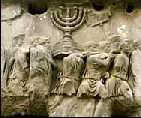
The Sack of Jerusalem depicted in the Arch of Titus, 70 AD
Ancient times
The land that now encompasses Israel and the Palestinian territories has been conquered and re-conquered throughout history.
Details of the ancient Israelite states are sketchy, derived for the most part from the first books of the Bible and classical history. Some of the key events include:
Biblical times
1250 BC: Israelites began to conquer and settle the land of Canaan on the eastern Mediterranean coast. 961-922 BC: Reign of King Solomon and construction of the Temple in Jerusalem. Solomon's reign was followed by the division of the land into two kingdoms. 586 BC: The southern kingdom, Judah, was conquered by the Babylonians, who drove its people, the Jews, into exile and destroyed Solomon's Temple. After 70 years the Jews began to return and Jerusalem and the temple were gradually rebuilt.
Classical period
333 BC: Alexander the Great's conquest brought the area under Greek rule. 165 BC: A revolt in Judea established the last independent Jewish state of ancient times. 63 BC: The Jewish state, Judea, was incorporated into the Roman province of Palestine 70 AD: A revolt against Roman rule was put down by the Emperor Titus and the Second Temple was destroyed. This marks the beginning of the Jewish Diaspora, or dispersion. 118-138 AD: During the Roman Emperor Hadrian's rule, Jews were initially allowed to return to Jerusalem, but - after another Jewish revolt in 133 - the city was completely destroyed and its people banished and sold into slavery. 638 AD: Conquest by Arab Muslims ended Byzantine rule (the successor to Roman rule in the East). The second caliph of Islam, Omar, built a mosque at the site of what is now the al-Aqsa Mosque in Jerusalem in the early years of the 8th Century. Apart from the age of the Crusaders (1099-1187), the region remained under Muslim rule until the fall of the Ottoman Empire in the 20th Century.
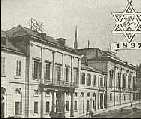
Basle: The venue of the First Zionist Congress
First Zionist Congress
The First Zionist Congress met in Basle, Switzerland, to discuss the ideas set out in Theodor Herzl's 1896 book Der Judenstaat (The Jewish State). Herzl, a Jewish journalist and writer living in Vienna, wanted Jews to have their own state - primarily as a response to European anti-Semitism.
The Congress issued the Basle Programme to establish a "home for the Jewish people in Palestine secured by public law" and set up the World Zionist Organisation to work for that end.
A few Zionist immigrants had already started arriving in the area before 1897. By 1903 there were some 25,000 of them, mostly from Eastern Europe. They lived alongside about half a million Arab residents in what was then part of the Turkish Ottoman Empire. A second wave of about 40,000 immigrants arrived in the region between 1904 and 1914.
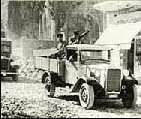
British forces failed to contain the violence
Arab discontent
|
"Take Jerusalem as a Christmas present, for the nation," wrote British prime minister David Lloyd George in the June of 1917 to General Allenby, who in December succeeded in outmaneuvering the Turks and attacked Jerusalem through Be'er Sheva. Indeed, it was a fine gift that the empire received that Christmas, but it never imagined what a bitter and thankless episode had begun.
Haaretz
|
The Zionist project of the 1920s and 1930s saw hundreds of thousands of Jews emigrating to British Mandate Palestine, provoking unrest in the Arab community.
In 1922, a British census showed the Jewish population had risen to about 11% of Palestine's 750,000 inhabitants. More than 300,000 immigrants arrived in the next 15 years.
Zionist-Arab antagonism boiled over into violent clashes in August 1929 when 133 Jews were killed by Palestinians and 110 Palestinians died at the hands of the British police.
Arab discontent again exploded into widespread civil disobedience during a general strike in 1936. By this time, the militant Zionist group Irgun Zvai Leumi was orchestrating attacks on Palestinian and British targets with the aim of "liberating" Palestine and Transjordan (modern-day Jordan) by force.
In July 1937, Britain, in a Royal Commission headed by former Secretary of State for India, Lord Peel, recommended partitioning the land into a Jewish state (about a third of British Mandate Palestine, including Galilee and the coastal plain) and an Arab one.
Palestinian and Arab representatives rejected this and demanded an end to immigration and the safeguarding of a single unified state with protection of minority rights. Violent opposition continued until 1938 when it was crushed with reinforcements from the UK.
Contact with Nazi authorities
In 1940 and 1941, Lehi proposed intervening in the Second World War on the side of Nazi Germany to attain their help in expelling Britain from Mandate Palestine and to offer their assistance in "evacuating" the Jews of Europe arguing that "common interests could exist between the establishment of a new order in Europe in conformity with the German concept, and the true national aspirations of the Jewish people as they are embodied by the NMO (Lehi)."
Late in 1940, Lehi representative Naftali Lubenchik was sent to Beirut where he met the German official Werner Otto von Hentig and delivered a letter from Lehi offering to "actively take part in the war on Germany's side" in return for German support for "the establishment of the historic Jewish state on a national and totalitarian basis, bound by a treaty with the German Reich". Von Hentig forwarded the letter to the German embassy in Ankara, but there is no record of any official response. Lehi tried to establish contact with the Germans again in December 1941, also apparently without success.
Document by Lehi to Nazi germany
Fundamental Features of the Proposal of the National Military Organization in Palestine
British Policy in Palestine
The Stern Gang
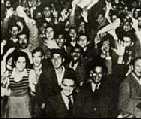
Jews in Tel Aviv celebrate the partition resolution
UN partition of Palestine
Britain, which had ruled Palestine since 1920, handed over responsibility for solving the Zionist-Arab problem to the UN in 1947.
The territory was plagued with chronic unrest pitting native Arabs against Jewish immigrants (who now made up about a third the population, owning about 6% of the land). The situation had become more critical with the displacement of hundreds of thousands of Jews fleeing the Nazi persecution in Europe. Some six million Jews were killed in the Holocaust during World War II.
The UN set up a special committee which recommended splitting the territory into separate Jewish and Palestinian states. Palestinian representatives, known as the Arab Higher Committee, rejected the proposal; their counterparts in the Jewish Agency accepted it.
The partition plan gave 56.47% of Palestine to the Jewish state and 43.53% to the Arab state, with an international enclave around Jerusalem. On 29 November 1947, 33 countries of the UN General Assembly voted for partition, 13 voted against and 10 abstained. The plan, which was rejected by the Palestinians, was never implemented.
Britain announced its intention to terminate its Palestine mandate on 15 May 1948 but hostilities broke out before the date arrived.
The death of British soldiers in the conflict made the continuing presence in Palestine deeply unpopular in Britain. In addition, the British resented American pressure to allow in more Jewish refugees - a sign of growing US suport for Zionism.
Both Arab and Jewish sides prepared for the coming confrontation by mobilising forces. The first "clearing" operations were conducted against Palestinian villages by Jewish forces in December.
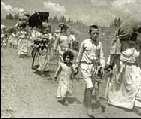
[pic 1948] Thousands of Palestinians were displaced
Establishment of Israel
The State of Israel, the first Jewish state for nearly 2,000 years, was proclaimed at 1600 on 14 May 1948 in Tel Aviv. The declaration came into effect the following day as the last British troops withdrew. Palestinians remember 15 May as "al-Nakba", or the Catastrophe.
The year had begun with Jewish and Arab armies each staging attacks on territory held by the other side. Jewish forces, backed by the Irgun and Lehi militant groups made more progress, seizing areas alloted to the Jewish state but also conquering substantial territories allocated for the Palestinian one.
Irgun and Lehi massacred scores of inhabitants of the village of Deir Yassin near Jerusalem on 9 April. Word of the massacre spread terror among Palestinians and hundreds of thousands fled to Lebanon, Egypt and the area now known as the West Bank.
The Jewish armies were victorious in the Negev, Galilee, West Jerusalem and much of the coastal plain.
The day after the state of Israel was declared five Arab armies from Jordan, Egypt, Lebanon, Syria and Iraq immediately invaded Israel but were repulsed, and the Israeli army crushed pockets of resistance. Armistices established Israel's borders on the frontier of most of the earlier British Mandate Palestine.
Egypt kept the Gaza Strip while Jordan annexed the area around East Jerusalem and the land now known as the West Bank. These territories made up about 25% of the total area of British Mandate Palestine.
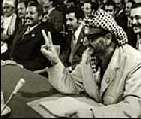
[pic 1964] Yasser Arafat embodied the armed struggle
Formation of the PLO
Since 1948 there had been fierce competition between neighbouring states to lead an Arab response to the creation of Israel. That left the Palestinians as passive onlookers.
In January 1964, Arab governments - wanting to create a Palestinian organisation that would remain essentially under their control - voted to create a body called the Palestine Liberation Organisation (PLO).
But the Palestinians wanted a genuinely independent body, and that was the goal of Yasser Arafat who took over the chairmanship of the PLO in 1969. His Fatah organisation (founded in secret five years earlier) was gaining notoriety with its armed operations against Israel.
Fatah fighters inflicted heavy casualties on Israeli troops at Karameh in Jordan in 1968.
|
|
Timeline of European Jewish persecution
305 In Elvira, a Spanish town in Andalusia near Granada, the first known laws of any church council against Jews appeared. Christian women were forbidden to marry Jews unless the Jew first converted to Christianity. Jews were forbidden to extend hospitality to Christians. Jews could not keep Christian concubines and were forbidden to bless the fields of Christians.
312 Constantine became emperor and converted to Christianity. Christianity could now be practiced openly and was officially tolerated for the first time.
391 The Edict of Theodosius declared that Christianity was to be the only legal religion in the Roman Empire.
589 In Christian Spain, the Third Council of Toledo ordered that children born of marriage between Jews and Christians be baptized by force. A policy of forced conversion of all Jews was initiated. Thousands fled. Thousands of others converted.
614 Chosroes II and his Persian (Sasanid) troops overran Palestine slaughtering thousands of Christians and destroying churches. The Jews supported the invaders in defiance of the emperor, Heraclius, who had previously ordered all Jews to be baptized.
629 Heraclius ousted the Persians and took bloody revenge upon the Jews.
680 In Spain, the Christian King Ewig ordered every Jew to be converted or face expulsion.
694 In Spain, the Christian King Egica accused Jews of treason. Property was confiscated, Jews were declared slaves, and were forbidden to practice their faith. It was decreed that their children be taken from them at age seven and be raised as Christians by tutors.
711 The Umayyad conquest of Spain began. Islam reached India (Indus river). Christian decrees against the Jews in Spain (see 305, 589, 680, 694) were reversed by the Muslim conquerors. Jews living in the region were invited by the Arabs to join in the creation of what became one of the highest achieving and tolerant cultures of the Middle Ages. (See Umayyad Spain for more)
848 In Bordeaux (France), Jews were accused of betraying the city to the invading Danes. In Toulouse on Easter, a Jew was publicly slapped in the face by the bishop as punishment for his people's betrayal of Jesus to the Romans. This had been a customary part of Easter observances in Toulouse for some years.
876 In Sens, southeast of Paris, Jews were expelled from the city.
1095 Pope Urban II proclaimed the First Crusade to liberate Christian holy places from the Muslim "infidels." The following year, large numbers of peasants with some knights among them with the vanguard led by Walter the Penniless made their way toward Jerusalem massacring Jews in the Rhineland as they went. Eight hundred Jews perished in Worms. More than a thousand Jews died in Mainz and were buried in mass graves. In all, five thousand Jews were killed in the Rhineland. Walter's army was stopped by Muslim forces in Dorylaeum in Asia Minor, but two other armies following him continued on toward Jerusalem, which they reached in 1099.
1171 The Jews of Blois (north central France) were accused of ritual murder, charged with slaying Christians (usually infants) to obtain blood for their Passover feasts. Jews were rumored among Christians to be inhuman, born of the devil, and in need of drinking human blood in order to retain human appearance. (Similar accusations were leveled against Jews in Norwich, England in 1144). On May 26, 1171, all 33 Jews in Blois, men, women, and children, were burned at the stake.
1190 A mob of English crusaders attacked the Jews of York. The Jews took refuge in the castle, then committed mass suicide. About the same time, Jews were officially designated slaves of the English king, Richard I, "the Lion Hearted" (1189-1199). Pope Innocent III (1198-1216) applauded the new decree.
1215 The same year the Magna Carta was signed in England, the Fourth Lateran Council (named after the Lateran Palace in Rome where it was held) was called by Pope Innocent III. He was instrumental in the formation of the Inquisitions. Jews and Moslems were ordered to wear distinctive clothing to set them apart from Christians. Jews were forbidden to hold public office.
1227 In Narbonne, all Jews were required to wear oval badges, and were forbidden to leave their homes during the Christian holy week.
1232 In Provence, the books of Maimonides (1135-1204), one of the greatest Jewish philosophers of the Middle Ages, were burned. (more on Maimonides)
1240 On June 25 in Paris, the Talmud was put on trial (this was the same city where a pig could be tried for murder). The accuser was Nicholas Donin, a Jewish convert to Christianity. The Talmud was condemned. On Friday, June 6, 1242, twenty four wagon loads of Jewish books were burned. The Jews smuggled in other copies. In 1248, there was another trial. Again the Talmud was condemned. Again the books were burned.
1290 Five thousand Jews were expelled from England and were taken in by French dukes.
1291 An army of 1,600 European peasant crusaders sent by Pope Nicholas IV landed at Akko and began massacring the inhabitants, Christians as well as Muslims and Jews.
1348 As the "Black Death" raged in Europe, in Germany Jews were accused of causing the plague by poisoning wells. Six thousand Jews were massacred in Mainz, and in Strasbourg, two thousand Jews were burned to death on a wooden scaffold built over a huge pit.
1394 Jews were expelled from France and wandered into Spain.
1469 The marriage of Ferdinand of Aragon to Isabella of Castille united the two chief kingdoms of Spain. Mass expulsions of Jews from Spain began. Also beginning at this time, Muslims were forcibly converted to Christianity (the conversos). Muslims, and Jews, too, fled or were arrested by the Inquisition.
1483 Tomas de Torquemada was appointed head of the Spanish Inquisition. In his twelve years in office, 13,000 Jewish converts to Christianity accused of practicing their original faith in secret were burned. The last burning occurred on October 27, 1765 in Portugal (the victim was a Jew).
1492 The same year Queen Isabella funded Columbus' journey to America, Christians captured Granada. On March 31, King Ferdinand and Queen Isabella signed an edict expelling Jews and Muslims from Spain. 100,000 to 200,000 wandered into North Africa while others found refuge in Ottoman domains. This marked the end of Arab civilization in Spain.
1543 Martin Luther published a pamphlet entitled On Jews and Their Lies. This was a period when Europe was especially rife with anti-Jewish sentiment. Jews had been expelled from England in 1290, from France in 1394, and from Spain in 1492. In addition, the inquisitions had been busy purging various quarters of their Jews, Muslims, witches, and other "heretics." Jews in particular had been singled out by superstitious European peasantry as practitioners of witchcraft and sorcery, poisoners of wells, blighters of crops, and eaters of Christian babies. The ecclesiastical authorities did little to stem these lies and in some cases actually promoted them.
Luther added fuel to the fire by asking the question, "What shall we do with this rejected and condemned people, the Jews?" Here are some of his suggestions:
"'First, to set fire to their synagogues or schools and to bury and cover with dirt whatever will not burn so that no man will ever again see a stone or cinder of them. This is to be done in honor of our Lord and of Christendom, so that God might see that we are Christians, and do not condone or knowingly tolerate such public lying, cursing, and blasphemy of his Son and of his Christians.'" (Martin Luther, Luther's Works, trans. by Martin H. Bertram (Philadelphia, 1971), 288).
Luther went on to recommend that the houses of Jews be, "'razed and destroyed,'" the Talmud be taken away from them, and that Germany should, "'emulate the common sense of other nations such as France, Spain, Bohemia, etc., compute with them how much their usury has extorted from us, divide this amicably, but then eject them forever from the country.'" (ibid, 272)
1553 In August, Pope Julius III (1550-1555) condemned the Talmud. One month later on Rosh Hashanah, a mountain of Jewish books was burned. In July 1555, the pope ordered Jews of the papal states into ghettos. Jews were forbidden to own property and were compelled to wear yellow hats. By 1612, all the Jews of Tuscany, Padua, Verona, and Mantua had been herded into ghettos. Their gates were locked at night by Christian gatekeepers whose salaries the Jewish internees were required to pay.
1648 The Chmielnicki Uprising broke out, a rebellion of Ukrainian Cossacks against their Polish overlords and the Polish Jews who functioned as tax collectors for these overlords. The uprising was led by Bogdan Chmielnicki. A letter written during the period recounts the capture of some towns by the Cossacks:
"'They slaughtered eight hundred noblemen together with their wives and children as well as seven hundred Jews, also with wives and children. Some were cut to pieces, others were ordered to dig graves into which Jewish women and children were thrown and buried alive. Jews were given rifles and ordered to kill one another '" (Chaim Potok, Wanderings (New York, 1978), 445)
1694 - 1778 Life of Voltaire: French philosopher and champion of the Enlightenment. His enlightened attitudes apparently did not extend to Jews, however. He wrote,
"'They are all of them, born with raging fanaticism in their hearts, just as the Bretons and The Germans are born with blond hair. I would not be in the least bit surprised if these people would not some day become deadly to the human race.'"
Voltaire went on to condemn them for "'their stubbornness, their new superstitions, and their hallowed usury.'" Addressing the Jews directly, Voltaire wrote, "'You have surpassed all nations in impertinent fables, in bad conduct, and in barbarism. You deserve to be punished, for this is your destiny. '" (Potok, Wanderings (New York: Fawcett Crest, 1978) 482-483)
ca. 1840 Russia began imposing restrictions on Jews. Pogroms (mass violent attacks on Jews) broke out in the 1880s.
1879 The neologism "anti-Semitism" was coined by a German writer and hater of Jews named Wilhelm Marrih in an attempt to replace the word Judenhass ("Jew-hatred") with a more "scientific" term. His intent was to sanitize and otherwise dress up discourse devoted to defaming Jews.
1881 Pogroms (riots against Jews) in Russia sparked the first wave of Jewish immigration into Palestine.
1886 In France, Edouard Drumont published his book Jewish France, in which he argued that the influence of Jews on France had been destructive. Drumont called for the ejection of the Jews from the country and the division of Jewish property. Anti-Semitic rallies followed.
1894 The "Dreyfus Affair" erupted in France. Alfred Dreyfus, a Jewish military officer, was charged with espionage. He was court-martialed and, on the basis of false documents forged by a fellow officer and political pressure fueled by the intense anti-Semitism in France at the time, he was convicted and sentenced to Devil's Island for life. From 1897 through 1899, there was a great public outcry in France demanding that this injustice be undone and the real spy, whom it was suspected the General Staff was concealing, be brought to trial. The fellow officer who had falsely accused Dreyfus had meanwhile committed suicide in prison. A new trial for Dreyfus in 1899 resulted in a second conviction, but his sentence was reduced and the President pardoned him. In 1906, he was finally exonerated. The term "intellectual" entered common usage at this time: used by those who thought Dreyfus was guilty as a term of scorn to discredit those who were arguing that he was innocent. It was the Dreyfus Affair that led Herzl to conclude that only a separate Jewish nation could guarantee Jewish safety.
1896 In the same year Marconi patented the wireless, Theodor Herzl, a journalist and playwright from Vienna, published The Jewish State which called for a Jewish national homeland. The Dreyfus Affair had irreversibly convinced Herzl that a separate Jewish nation was the only guarantee of Jewish safety. See Roots of the Arab-Israeli Conflict
1897 The first Zionist Conference was held in Basel, led by the founder of the movement, Theodor Herzl. In response to renewed, virulent anti-Jewish persecution, especially in Russia, Herzl called for a free state for the Jews in Palestine. Note that the call went out during a period of intensive European colonial activity in the Middle East and Africa. It was the Dreyfus Affair that led Herzl to conclude that only a separate Jewish nation could guarantee Jewish safety.
The vision of restoring "Zion" (one of the names for Jerusalem, and by extension all the territory associated with ancient Israel and Judah) had been active among Puritan and evangelical Christians in Europe as well as well as among Jews. Two English Puritans, Joanna and Ebenezer Cartwright, petitioned the British and Dutch governments in the mid 1600s to become "the first and the readiest to transport Izraell's sons and daughters in their ships to the Land promised by their forefathers, Abraham, Isaac, and Jacob for an everlasting Inheritance." Puritans believed that the second coming of the Messiah could occur only after the Jews had been restored to Zion. In the first half of the nineteenth century, Britain's Lord Palmerston extended British consular protection to Jews living in Palestine and promoted the idea of a Jewish Palestine as a way of propping up the crumbling Ottoman Empire. (See David Fromkin, A Peace to End All Peace: The Fall of the Ottoman Empire and the Creation of the Modern Middle East (New York: Henry Holt, 1989), 268ff.)
In his diaries, Zionism's founder Theodor Herzl took a hard stance toward the Arabs. In an entry written in 1895, he said, "'We shall have to spirit the penniless population across the border by procuring employment for it in the transit countries, while denying it any employments in our own country. Both the process of expropriation and the removal of the poor must be carried out discretely and circumspectly.'" (quoted by Edward Said, The Question of Palestine (New York: Vintage Books, 1992, 13))
ca. 1900 The Protocols of the Elders of Zion appeared in print in Russia for the first time. This was an anti-Semitic treatise believed to have been composed by members of the Russian Secret Police in Paris during the last few years of the nineteenth century. The Protocols argued that a worldwide conspiracy existed among Jewish leaders to set Christian nations against one another and dominate the world. As H.H. Ben-Sasson explains, "The authors took a pamphlet by a French lawyer, Maurice Joly, which had appeared in the 1860s and was directed against Napoleon III, leaving it almost untouched and substituting the leaders of world Jewry as the object of the attack." (H.H. Ben-Sasson (ed.), A History of the Jewish People (Cambridge, MA: Harvard University Press, 1976), 981) The treatise circulated widely in Russia, Germany, France, the United States (where it inspired a series of anti-Semitic articles in the 1920s in a weekly owned by Henry Ford).
1935 On September 15, the Nuremberg Laws were enacted in Germany. Jews were legally stripped of citizenship. Germans and Jews were forbidden to intermarry. Intercourse between Jews and Aryans was punishable by death. The rationale was to prevent "racial pollution" of Aryan peoples (it is worth remembering that anthropologists tell us that by the Neolithic period (20,000-2,000 B.C.E.) there was no pure Aryan race or racial purity of any other kind).
1938 On November 9, "Kristalnacht" ("night of broken glass") marked the beginning of the holocaust. There were actually two consecutive nights of Nazi violence against Jewish shops and businesses in German cities.
1945 Germany surrendered to the allies bringing the European theatre of World War II to a close. Allied armies liberating the POW and concentration camps confirmed what many had feared: that for years the Nazis had engaged in the mass extermination of European Jews according to a plan designed to eliminate "inferior" races. Six million Jews (1.5 million of whom were children) were killed between 1933 and 1945, an event called simply, the "Holocaust," from the Hebrew word ola ("burnt offering"). Two thirds of European Jewry (one third of all Jews worldwide) were annihilated.
|
|
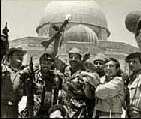
[pic 1967] Israeli soldiers celebrate at Jerusalem's holy sites
The 1967 War
Mounting tensions between Israel and its Arab neighbours culminated in six days of hostilities starting on 5 June 1967 and ending on 11 June - six days which changed the face of the Middle East conflict.
Israel seized Gaza and the Sinai from Egypt in the south and the Golan Heights from Syria in the north. It also pushed Jordanian forces out of the West Bank and East Jerusalem.
Egypt's powerful air force was put out of action on the first day of fighting when Israeli jets bombed it on the ground in a pre-emptive strike.
The territorial gains doubled the area of land controlled by Israel. The victory heralded a new age of confidence and optimism for Israel and its supporters.
The UN issued Security Council Resolution 242, stressing "the inadmissibility of the acquisition of territory by war" and calling for "withdrawal of Israeli armed forces from territories occupied in the recent conflict".
According ot the UN, the conflict displaced another 500,000 Palestinians who fled to Egypt, Syria, Lebanon and Jordan.
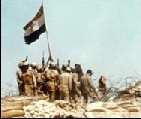
[pic 1973] Jubilant Egyptian soldiers plant flag on Bar-Lev line bunker in Sinai
The 1973 Yom Kippur war
Unable to regain the territory they had lost in 1967 by diplomatic means, Egypt and Syria launched major offensives against Israel on the Jewish festival of the Day of Atonement or Yom Kippur. The clashes are also known as the Ramadan war.
Initially, Egypt and Syria made advances in Sinai and the Golan Heights. These were reversed after three weeks of fighting. Israel eventually made gains beyond the 1967 ceasefire lines.
Israeli forces pushed on into Syria beyond the Golan Heights, though they later gave up some of these gains. In Egypt, Israeli forces regained territory and advanced to the western side of the Suez Canal.
The United States, the Soviet Union and the United Nations all made diplomatic interventions to bring about ceasefire agreements between the combatants.
Egypt and Syria jointly lost an estimated 8,500 soldiers in the fighting, while Israel lost about 6,000.
The war left Israel more dependent on the US for military, diplomatic and economic support. Soon after the war, Saudi Arabia led a petroleum embargo against states that supported Israel. The embargo, which caused a steep rises in petrol prices and fuel shortages across the world, lasted until March 1974. In October 1973 the UN Security Council passed resolution 338 which called for the combatants "to cease all firing and terminate all military activity immediately... [and start] negotiations between the parties concerned under appropriate auspices aimed at establishing a just and durable peace in the Middle East".
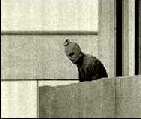
[pic 1974] Eleven Israeli athletes were killed at the Olympics in 1972
Arafat's first UN appearance
In the 1970s, under Yasser Arafat's leadership, PLO factions and other militant Palestinian groups such as Abu Nidal launched a series of attacks on Israeli and other targets.
One such attack took place at the Munich Olympics in 1972 in which 11 Israeli athletes were killed.
But while the PLO pursued the armed struggle to "liberate all of Palestine", in 1974, Arafat made a dramatic first appearance at the United Nations mooting a peaceful solution.
He condemned the Zionist project, but concluded: "Today I have come bearing an olive branch and a freedom fighter's gun. Do not let the olive branch fall from my hand."
The speech was a watershed in the Palestinians' search for international recognition of their cause.
A year later, a US State Department official, Harold Saunders, acknowledged for the first time that "the legitimate interests of the Palestinian Arabs must be taken into account in the negotiating of an Arab-Israeli peace".
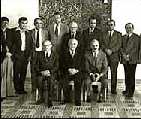
[pic 1977] The election ends Likud's long period in opposition
Israel's resurgent right wing
Hardline Irgun and Lehi groups may have been instrumental in the creation of Israel in 1948, but their heirs in the Herut (later Likud) party failed to win an Israeli election until 1977.
Until this time Israeli politics had been dominated by the left-wing Labour Party. Likud ideology focused on extending Israeli sovereignty in the whole of the earlier Britsh Mandate Palestine, as well as claiming Jordanian territory as part of the "Greater Israel" of Biblical times.
The new government, led by former Irgun leader Menachem Begin, intensified Israeli settlement activity in the West Bank and Gaza with a view to creating "facts on the ground" to prevent any future territorial compromise over the areas captured in 1967.
Agriculture minister Ariel Sharon spearheaded this movement as chairman of the ministerial committee for settlements until 1981.

[Pic 1979] The handshake marks an end to hostility
Israel and Egypt make peace
Egyptian President Anwar Sadat stunned the world by flying to the Jewish state and making a speech to the Israeli parliament in Jerusalem on 19 November 1977.
Sadat became the first Arab leader to recognise Israel, only four years after launching the October 1973 war (known as the Yom Kippur war in Israel). The war was indecisive after Egypt and Syria had attacked Israeli forces occupying Sinai and the Golan Heights. It ended with the issuing of UN Resolution 338 calling for "a just and durable peace in the Middle East".
Egypt and Israel signed the Camp David accords in September 1978 outlining "the framework for peace in the Middle East" which included limited autonomy for Palestinians. A bilateral Egyptian-Israeli peace treaty was signed by Sadat and Israeli Prime Minister Menachem Begin six months later in March 1979.
The Sinai Peninsula, which Israel had seized in the 1967 war, was returned to Egypt.
Arab states boycotted Egypt for breaking ranks and negotiating a separate treaty with Israel.
Sadat was assassinated in 1981 by Islamist elements in the Egyptian army, who opposed peace with Israel, during national celebrations to mark the anniversary of the October war.

[pic 1982]Ariel Sharon resigned as defence minister after being criticised for his role in the Lebanon massacres
Israel invades Lebanon
The Israeli army launched a massive military incursion into Lebanon in the summer of 1982. Operation "Peace for Galilee" was intended to wipe out Palestinian guerrilla bases near Israel's northern border, although Defence Minister Ariel Sharon pushed all the way to Beirut and expelled the PLO from the country.
The invasion began on 6 June, less than two months after the last Israeli troops and civilians were pulled out of Sinai under the 1979 treaty with Egypt. The action was triggered by the attempt on the life of Israeli ambassador to London Shlomo Argov by the dissident Palestinian group Abu Nidal.
Israeli troops reached Beirut in August. A ceasefire agreement allowed the departure of PLO fighters from Lebanon, leaving Palestinian refugee camps defenceless.
As Israeli forces gathered around Beirut on 14 September, Bashir Gemayel, leader of the Christian Phalange militia, was killed by a bomb at his HQ in the capital. The following day, the Israeli army occupied West Beirut.
From 16 to 18 September, the Phalangists - who were allied to Israel - killed hundreds of Palestinians in the Sabra and Shatila refugee camps as they were encircled by Israeli troops in one of the worst atrocities of nearly a century of conflict in the Middle East. Mr Sharon resigned from his post as defence minister after a 1983 Israeli inquiry concluded that he had failed to act to prevent the massacre.
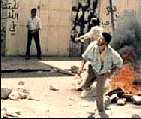
[pic 1987] The intifada put pressure on both the PLO and Israel
Palestinian intifada
A mass uprising - or intifada - against the Israeli occupation began in Gaza and quickly spread to the West Bank.
Protest took the form of civil disobedience, general strikes, boycotts on Israeli products, graffiti, and barricades, but it was the stone-throwing demonstrations against the heavily-armed occupation troops that captured international attention.
The Israeli Defence Forces responded and there was heavy loss of life among Palestinian civilians. More than 1,000 died in clashes which lasted until 1993.
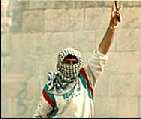
[pic1988] The intifida proved more powerful than had been expected
PLO opens door to peace
Despite its military might, Israel was unable to quell the intifada which started in 1987 and was backed by the entire Palestinian population living under Israeli occupation.
For the PLO - based in Tunis since its expulsion from Lebanon in 1982 - the uprising threatened the loss of its role as the main player in the Palestinian "revolution" as focus shifted to the occupied territories and away from the diaspora population.
The Palestinian National Council (a government-in-exile) convened in Algeria in November 1988 and voted to accept a "two-state" solution based on the 1947 UN partition resolution (181), renounce terrorism and seek a negotiated settlement based on Resolution 242, which called for Israel to withdraw from territory captured in the 1967 war, and Resolution 338.
The US began dialogue with the PLO. But Israel continued to view the PLO as a terrorist organisation with which it would not negotiate. Instead, Israeli Prime Minister Yitzhak Shamir proposed elections in the occupied territories before negotiations on a self-rule agreement.
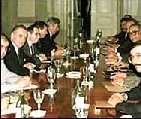
[pic 1991] Conference opens the way for bilateral talks
Madrid Summit
The 1991 Gulf War was a disaster for the PLO and its leader Yasser Arafat whose support for Iraq alienated his wealthy supporters in the Gulf.
With Kuwait liberated from Iraqi control, the US administration devoted itself to Middle East peacemaking - a prospect more appealing to the financially weakened and politically isolated Arafat than Israel's hard-line Likud prime minister Yitzhak Shamir.
Numerous visits by the US Secretary of State James Baker prepared the ground for an international summit in Madrid. Syria agreed to attend, hoping to negotiate a return of the Golan Heights. Jordan also accepted the invitation.
But Shamir refused to talk directly with PLO "terrorists", so a joint Jordanian-Palestinian delegation was formed with prominent Palestinian figures- who were not from the PLO - taking part. In the days before the summit, Washington withheld $10bn of loan guarantees from Israel in a rare moment of discord over the building of Jewish settlements in the occupied territories.
A worldwide audience watched the historic summit begin on 30 October. The old enemies were each given 45 minutes to set out their positions. The Palestinians spoke of a shared future of hope with Israel, Shamir justified the existence of the Jewish state, while Syrian Foreign Minister Farouq al-Shara dwelled on Mr Shamir's "terrorist" past.
After the summit the US set up separate bilateral meetings in Washington between Israel and Syria, and with the Jordanian-Palestinian delegations.
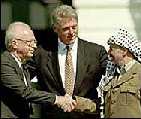
[pic 1993] Historic handshake at the White House
The Oslo Peace Process
The election of the left-wing Labour government in June 1992, led by Yitzhak Rabin, triggered a period of frenetic Israeli-Arab peacemaking in the mid-1990s.
The government - including the "iron-fisted" Rabin and doves Shimon Peres and Yossi Beilin - was uniquely placed to talk seriously about peace with the Palestinians. The PLO, meanwhile, wanted to make peace talks work because of the weakness of its position due to the Gulf War.
Israel immediately lifted a ban on PLO participants in the stalemated bilateral meetings in Washington. More significantly Foreign Minister Peres and his deputy Beilin explored the possibility of activating a secret forum for talks facilitated by Norway.
With the Washington bilateral talks going nowhere, the secret "Oslo track" - opened on 20 January 1993 in the Norwegian town of Sarpsborg - made unprecedented progress. The Palestinians consented to recognise Israel in return for the beginning of phased dismantling of Israel's occupation.
Negotiations culminated in the Declaration of Principles, signed on the White House lawn and sealed with a historic first handshake between Rabin and Yasser Arafat watched by 400 million people around the world.

[pic 1994] Yasser Arafat's triumphal return to Gaza
Birth of the Palestinian Authority
On 4 May 1994 Israel and the Palestinian Liberation Organisation reached an agreement in Cairo on the initial implementation of the 1993 Declaration of Principles. This document specified Israel's military withdrawal from most of the Gaza Strip, excluding Jewish settlements and land around them, and from the Palestinian town of Jericho in the West Bank. Negotiations were difficult and were almost derailed on 25 February when a Jewish settler in the West Bank town of Hebron fired on praying Muslims, killing 29 people.
The agreement itself contained potential pitfalls. It envisaged further withdrawals during a five-year interim period during which solutions to the really difficult issues were to be negotiated - issues such as the establishment of a Palestinian state, the status of Jerusalem, Jewish settlements in the Occupied Territories and the fate of more than 3.5 million Palestinian refugees from the 1948 and 1967 upheavals.
Many critics of the peace process were silenced on 1 July as jubilant crowds lined the streets of Gaza to cheer Yasser Arafat on his triumphal return to Palestinian territory. The returning Palestinian Liberation Army deployed in areas vacated by Israeli troops and Arafat became head of the new Palestinian National Authority (PA) in the autonomous areas. He was elected president of the Authority in January 1996.
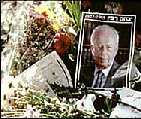
[pic 1995] Rabin's death ends the momentum towards peace
Oslo II and the assassination of Rabin
The first year of Palestinian self-rule in Gaza and Jericho was dogged by difficulties. Bomb attacks by Palestinian militants killed dozens of Israelis, while Israel blockaded the autonomous areas and assassinated militants. Settlement activity continued. The Palestinian Authority quelled unrest by mass detentions. Opposition to the peace process grew among right-wingers and religious nationalists in Israel.
Against this background, peace talks were laborious and fell behind schedule. But on 24 September the so-called Oslo II agreement was signed in Taba in Egypt, and countersigned four days later in Washington.
The agreement divided the West Bank into three zones:
Zone A comprised 7% of the territory (the main Palestinian towns excluding Hebron and East Jerusalem) going to full Palestinian control; Zone B comprised 21% of the territory under joint Israeli-Palestinian control; Zone C stayed in Israeli hands. Israel was also to release Palestinian prisoners. Further handovers followed.
Oslo II was greeted with little enthusiasm by Palestinians, while Israel's religious right was furious at the "surrender of Jewish land". Amid an incitement campaign against Israeli Prime Minister Yitzhak Rabin, a Jewish religious extremist assassinated him on 4 November, sending shock waves around the world. The dovish Shimon Peres, architect of the faltering peace process, became prime minister.
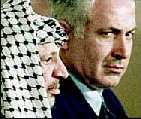
[pic 1996] A new mistrust enters Mid-East dialogue
Deadlock
Conflict returned early in 1996 with a series of devastating suicide bombings in Israel carried out by the Islamic militant group Hamas, and a bloody three-week bombardment of Lebanon by Israel.
Peres narrowly lost elections on 29 May to the right-wing Binyamin "Bibi" Netanyahu, who campaigned against the Oslo peace deals under the motto "Peace with Security".
Netanyahu soon enflamed Arab opinion by lifting a freeze on building new settlements in the occupied territories and provoking fears about undermining Muslim holy sites in Jerusalem by opening an archaeological tunnel under the compound of al-Aqsa mosque - one of Islam's holiest sites.
Despite his antagonism towards the existing peace process, Netanyahu, under increasing US pressure, handed over 80% of Hebron in January 1997 and signed the Wye River Memorandum on 23 October 1998 outlining further withdrawals from the West Bank.
But his right-wing coalition collapsed in January 1999 in disarray over the implementation of the Wye deal. He lost elections on 18 May to Labour's Ehud Barak who pledged to "end the 100-year conflict" between Israel and the Arabs within one year.
The five-year interim period defined by Oslo for a final resolution passed on 4 May 1999, but Yasser Arafat was persuaded to defer unilateral declaration of Palestinian statehood to give a chance for negotiations with the new administration.
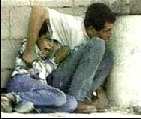
[pic 2000] The shooting of Gaza boy Muhammad al-Durrah by Israeli troops shocked the world
Second intifada
Initial optimism about the peacemaking prospects of a government led by Ehud Barak proved unfounded. A new Wye River accord was signed in September 1999 but further withdrawals from occupied land were hindered by disagreements and final status talks (on Jerusalem, refugees, settlements and borders) got nowhere. Frustration was building in the Palestinian population who had little to show for five years of the peace process.
Barak concentrated on peace with Syria - also unsuccessfully. But he did succeed in fulfilling a campaign pledge to end Israel's 21-year entanglement in Lebanon.
After the withdrawal from Lebanon in May 2000, attention turned back to Yasser Arafat, who was under pressure from Barak and US President Bill Clinton to abandon gradual negotiations and launch an all-out push for a final settlement at the presidential retreat at Camp David. Two weeks of talks failed to come up with acceptable solutions to the status of Jerusalem and the right of return of Palestinian refugees.
In the uncertainty of the ensuing impasse, Ariel Sharon, the veteran right-winger who succeeded Binyamin Netanyahu as Likud leader, toured the al-Aqsa/Temple Mount complex in Jerusalem on 28 September. Sharon's critics saw it as a highly provocative move. Palestinian demonstrations followed, quickly developing into what became known as the al-Aqsa intifada, or uprising.
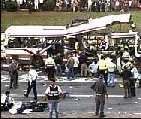
[pic 2001] Suicide bombs
The crisis escalates
By the end of 2000 Israeli Prime Minister Ehud Barak found himself presiding over an increasingly bitter and bloody cycle of violence as the intifada raged against Israel's occupation in the West Bank and Gaza.
With his coalition collapsing around him, Barak resigned as prime minister on 10 December to "seek a new mandate" to deal with the crisis. However in elections on 6 Febuary, Ariel Sharon was swept to power by an Israeli electorate that had overwhelmingly turned its back on the land-for-peace formulas of the 1990s and now favoured a tougher approach to Israel's "Palestinian problem".
The death toll soared as Sharon intensified existing policies such as assassinating Palestinian militants, air strikes and incursions into Palestinian self-rule areas. Palestinian militants, meanwhile, stepped up suicide bomb attacks in Israeli cities.
The US spearheaded international efforts to calm the violence. Envoy George Mitchell led an inquiry into the uprising, while CIA director George Tenet negotiated a ceasefire - but neither initiative broke the cycle of bloodshed.
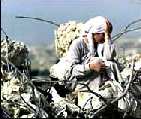
[pic 2002]A war of words raged after the Israeli army went into Jenin
West Bank re-occupied
After waves of suicide attacks early in the year, Israel re-occupied almost all of the West Bank in March, and again in June. For most of 2002, Palestinian cities were regularly raided, remained cut off from each other, surrounded and under curfew for long periods of time.
In April, Israeli forces entered and captured the refugee camp in northern West Bank city of Jenin. The Palestinians claimed massacre. The Israeli army, which took heavy casualties, said it met heavy organised resistance, and insisted that 52 Palestinians were killed.
A UN report criticised both sides for "violence that placed civilians in harm's way", and concluded that there was no massacre of civilians. A report by the human rights group Amnesty International concluded however that that the Israeli army had committed war crimes during its incursions into the West Bank towns of Jenin and Nablus.
In May, a five-week standoff at Bethlehem's Church of the Nativity ended when 13 Palestinian militants were sent into exile. A large group of Palestinians had taken refuge in the church when Israeli troops moved into the town.
Israeli officials said the operations in the West Bank and Gaza throughout 2002 were aimed at destroying the Palestinian terrorist infrastructure. Through the year, suicide attacks continued, though at a reduced rate.
For the second year running the peace process was in deep freeze. The Quartet, the United States, Russia, the United Nations and the European Union tried to revive it with the "roadmap" for Middle East settlement. The publication of the document was delayed by wrangling over its contents in 2002. Diplomatic initiatives were put on hold until after the US-led war in Iraq in April 2003 when the roadmap was published.
In June, President George Bush made a long-anticipated statement on the Middle East. He called for Palestinians to replace their leader with one not "compromised by terror".
original
|
|









Isreal / Palastine
Spot the difference...
Isreal



Israeli Prime Minister Ariel Sharon's plans for a new Mideast war, PLANS THAT WERE SET IN MOTION WITHIN DAYS OF HIS TAKING OFFICE EARLIER THIS YEAR, AND WHICH ARE NOW SET TO BE ACTIVATED. According to the sources, shortly after he was elected, Sharon met with a group of trusted political and military allies, and spelled out, in several confidential memos, A WAR PLAN TARGETTING THE PALESTINIAN AUTHORITY, the Hashemite Kingdom of Jordan, and other Arab neighbors.
- Sharon War Plan Exposed: Hamas Gang Is His Tool by Jeffrey Steinberg
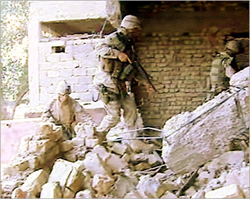
US or Isreali troops?
in Iraq or Palastine?
Iraq
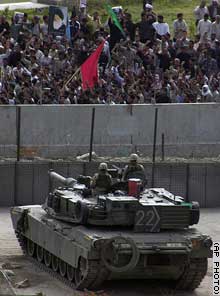
"...the abduction and now apparent murder of Margaret Hassan is a counterinsurgency intelligence operation run by the Americans, the Israelis, or both, as a way to sow chaos and discredit the Iraqi resistance (a resistance the United States cannot possibly hope to crush militarily). Discrediting the resistance is particularly important, as a psychological warfare tactic. - Margaret Hassan execution: Anatomy of a CIA-DIA-Mossad Counterinsurgency operation?"
separation barrier
|
|
|
